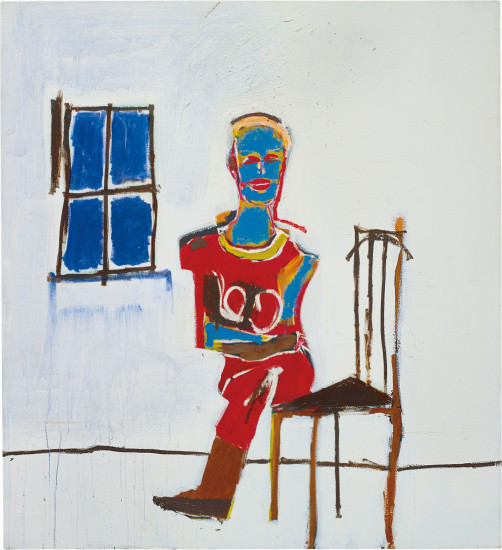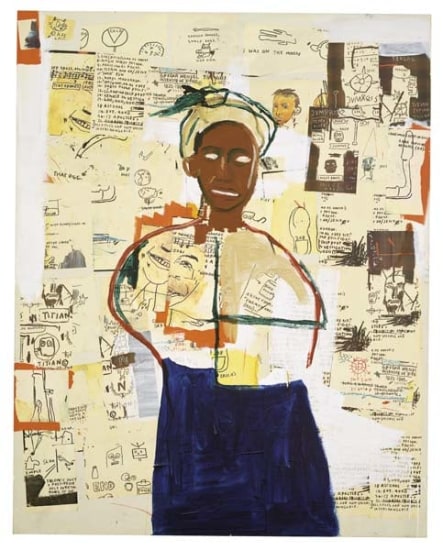Jean-Michel-Basquiat Untitled 1984 Acrylic and xerox collage on canvas. 109 x 109 cm. (43 x 43 in). Signed and dated 'Jean-Michel Basquiat 1984' on the reverse. This work is accompanied by a certificate of authenticity issued by the Authentication Committee of the Estate of Jean-Michel-Basquiat.
Provenance Galerie Bruno Bischofberger, Zurich Exhibited Vienna, Kunsthaus, Jean-Michel-Basquiat, 1999; Museum Wurth Kunzelsau, Jean-Michel-Basquiat- The Mugrabi Collection, 6 October, 2001 - 1 January, 2002 Literature R. Marshall E. Navarra and J.L. Prat, Jean-Michel-Basquiat, Paris, 2000, vol. II, p. 210 (illustrated) Catalogue Essay Jean-Michel-Basquiat, both the artist and his acclaimed oeuvre, requires no introduction. His story is well-known to all: the artist-rebel hailing from a poor, immigrant background who, after living on the streets of New York City, had a meteoric rise to the top of the art world only to fall even faster and harder, tragically consumed by a debilitating drug habit and sense of low self-esteem. Like many of history’s artistic prodigies – the tormented Vincent van Gogh comes most immediately to mind – Basquiat departed this world never having really belonged but not without leaving behind an influential and brilliant oeuvre in just eight brief years. Basquiat displayed an exceptional ability to execute poignant paintings loaded with attitude and turmoil and which present the infinite layers of a consciousness grappling with the transcendental, existential issue of the meaning of life and death that has always confronted humanity. The present lot, an untitled canvas, dates from the middle of Basquiat’s short but prolific career, in which the young artist began to reflect on his personal success and excess, his stardom and wealth and the hypocrisy of the New York art world. By 1984, the 24-year-old Basquiat had achieved it all: Larry Gagosian, Tony Shafrazi and Bruno Bischofberger sold his work across the world for substantial sums, he had solo museum shows and was very close to Madonna and Andy Warhol with whom he collaborated artistically. At the same time, however, he grew paranoid, fearing that everyone around him was simply interested in taking advantage of his fame and generosity. As a result, Basquiat sought self-destructive escapes with his cocaine and heroin addictions which inevitably spiralled out of control. As a largely autobiographical artist, Basquiat’s mature works from this period naturally reflect his dark mood. As some of the most powerful within his oeuvre, they retain the raw, expressive energy of his early works while also displaying the personal torment which would lead to his eventual demise. Central to the present lot is a cipher-like skull which could be read as a selfportrait. The haunting, ghost like figure with its hollow eyes, while clearly referencing African tribal masks, could be alluding to the institutional racism Basquiat perceived within modern American society and the New York art world. His interest in Black history is constant throughout his career, but from this moment on an obsession with mortality permeates his art, to the point where his final work is apocalyptically titled Riding with Death. In addition to the central black skull, there are several other depictions of skulls found in Untitled amongst the colour facsimiles collaged to the canvas. It is well known that Basquiat had a fascination with the human anatomy; as a child, while recovering in hospital from an accident, his mother gave him a copy of Gray’s Anatomy. Although self-taught, he was keenly aware of the history of art and Leonardo da Vinci’s numerous drawings of the human skull. Far from being scientifically accurate, Basquiat’s renditions are raw and chilling, powerfully capturing the angst and rage that must have inhabited the tormented soul that he was. The last, but certainly not the least, of the motifs of note in Untitled is Basquiat’s use of words. Found throughout his oeuvre, Basquiat’s consciously child-like scribbles and cryptic writings are known to have been influenced by Jean Dubuffet and Cy Twombly While painting in the basement of Annina Nosei’s gallery, Basquiat had a book open to pages illustrating Twombly’s large, lyrical compositions which incorporate text and image. Whe
Jean-Michel-Basquiat Untitled 1984 Acrylic and xerox collage on canvas. 109 x 109 cm. (43 x 43 in). Signed and dated 'Jean-Michel Basquiat 1984' on the reverse. This work is accompanied by a certificate of authenticity issued by the Authentication Committee of the Estate of Jean-Michel-Basquiat.
Provenance Galerie Bruno Bischofberger, Zurich Exhibited Vienna, Kunsthaus, Jean-Michel-Basquiat, 1999; Museum Wurth Kunzelsau, Jean-Michel-Basquiat- The Mugrabi Collection, 6 October, 2001 - 1 January, 2002 Literature R. Marshall E. Navarra and J.L. Prat, Jean-Michel-Basquiat, Paris, 2000, vol. II, p. 210 (illustrated) Catalogue Essay Jean-Michel-Basquiat, both the artist and his acclaimed oeuvre, requires no introduction. His story is well-known to all: the artist-rebel hailing from a poor, immigrant background who, after living on the streets of New York City, had a meteoric rise to the top of the art world only to fall even faster and harder, tragically consumed by a debilitating drug habit and sense of low self-esteem. Like many of history’s artistic prodigies – the tormented Vincent van Gogh comes most immediately to mind – Basquiat departed this world never having really belonged but not without leaving behind an influential and brilliant oeuvre in just eight brief years. Basquiat displayed an exceptional ability to execute poignant paintings loaded with attitude and turmoil and which present the infinite layers of a consciousness grappling with the transcendental, existential issue of the meaning of life and death that has always confronted humanity. The present lot, an untitled canvas, dates from the middle of Basquiat’s short but prolific career, in which the young artist began to reflect on his personal success and excess, his stardom and wealth and the hypocrisy of the New York art world. By 1984, the 24-year-old Basquiat had achieved it all: Larry Gagosian, Tony Shafrazi and Bruno Bischofberger sold his work across the world for substantial sums, he had solo museum shows and was very close to Madonna and Andy Warhol with whom he collaborated artistically. At the same time, however, he grew paranoid, fearing that everyone around him was simply interested in taking advantage of his fame and generosity. As a result, Basquiat sought self-destructive escapes with his cocaine and heroin addictions which inevitably spiralled out of control. As a largely autobiographical artist, Basquiat’s mature works from this period naturally reflect his dark mood. As some of the most powerful within his oeuvre, they retain the raw, expressive energy of his early works while also displaying the personal torment which would lead to his eventual demise. Central to the present lot is a cipher-like skull which could be read as a selfportrait. The haunting, ghost like figure with its hollow eyes, while clearly referencing African tribal masks, could be alluding to the institutional racism Basquiat perceived within modern American society and the New York art world. His interest in Black history is constant throughout his career, but from this moment on an obsession with mortality permeates his art, to the point where his final work is apocalyptically titled Riding with Death. In addition to the central black skull, there are several other depictions of skulls found in Untitled amongst the colour facsimiles collaged to the canvas. It is well known that Basquiat had a fascination with the human anatomy; as a child, while recovering in hospital from an accident, his mother gave him a copy of Gray’s Anatomy. Although self-taught, he was keenly aware of the history of art and Leonardo da Vinci’s numerous drawings of the human skull. Far from being scientifically accurate, Basquiat’s renditions are raw and chilling, powerfully capturing the angst and rage that must have inhabited the tormented soul that he was. The last, but certainly not the least, of the motifs of note in Untitled is Basquiat’s use of words. Found throughout his oeuvre, Basquiat’s consciously child-like scribbles and cryptic writings are known to have been influenced by Jean Dubuffet and Cy Twombly While painting in the basement of Annina Nosei’s gallery, Basquiat had a book open to pages illustrating Twombly’s large, lyrical compositions which incorporate text and image. Whe

.jpg)









Try LotSearch and its premium features for 7 days - without any costs!
Be notified automatically about new items in upcoming auctions.
Create an alert